Spatial Assessment of Urban Flood Susceptibility Using Data Mining and Geographic Information System (GIS) Tools
Abstract
:1. Introduction
2. Study Area
3. Spatial Datasets
4. Method
5. Result
5.1. Relationships between Flooded Area and Related Factors
5.2. Flood Susceptibility Mapping and Its Validation
6. Discussion and Conclusions
Acknowledgments
Author Contributions
Conflicts of Interest
References
- Pachauri, R.K.; Allen, M.R.; Barros, V.R.; Broome, J.; Cramer, W.; Christ, R.; Church, J.A.; Clarke, L.; Dahe, Q.; Dasgupta, P. Climate Change 2014: Synthesis Report. Contribution of Working Groups I, II and III to the Fifth Assessment Report of the Intergovernmental Panel on Climate Change; IPCC: Geneva, Switzerland, 2014. [Google Scholar]
- Solomon, S. Climate Change 2007: The Physical Science Basis: Working Group I Contribution to the Fourth Assessment Report of the IPCC; Cambridge University Press: Cambridge, UK, 2007; Volume 4. [Google Scholar]
- Muneerudeen, A. Urban and Landscape Design Strategies for Flood Resilience in Chennai City; Qatar University: Doha, Qatar, 2017. [Google Scholar]
- Murray, V.; Ebi, K.L. IPCC Special Report on Managing the Risks of Extreme Events and Disasters to Advance Climate Change Adaptation (SREX); BMJ Publishing Group Ltd.: London, UK, 2012. [Google Scholar]
- Fayyad, U.; Piatetsky-Shapiro, G.; Smyth, P. From Data Mining to Knowledge Discovery in Databases; AI Magazine: California, USA, 1996; Volume 17, p. 37. [Google Scholar]
- Aronson, J.E.; Liang, T.P.; Turban, E. Decision Support Systems and Intelligent Systems; Pearson Prentice-Hall: Upper Saddle River, New Jersey, NJ, USA, 2005. [Google Scholar]
- Lee, S.; Lee, M.J.; Jung, H.S. Data mining approaches for landslide susceptibility mapping in Umyeonsan, Seoul, South Korea. Appl. Sci. 2017, 7, 683. [Google Scholar] [CrossRef]
- Diakakis, M.A. Method for flood hazard mapping based on basin morphometry: Application in two catchments in Greece. Nat. Hazards 2011, 56, 803–814. [Google Scholar] [CrossRef]
- Hardmeyer, K.; Spencer, M.A. Using risk-based analysis and geographic information systems to assess flooding problems in an urban watershed in Rhode Island. Environ. Manag. 2007, 39, 563–574. [Google Scholar] [CrossRef] [PubMed]
- Morelli, S.; Segoni, S.; Manzo, G.; Ermini, L.; Catani, F. Urban planning, flood risk and public policy: The case of the Arno River, Firenze, Italy. Appl. Geogr. 2012, 34, 205–218. [Google Scholar] [CrossRef]
- Harun, N.A.; Makhtar, M.; Aziz, A.A.; Zakaria, Z.A.; Abdullah, F.S.; Jusoh, J.A. The application of apriori algorithm in predicting flood areas. Int. J. Adv. Sci. Eng. Inf. Technol. 2017, 7, 763–769. [Google Scholar] [CrossRef]
- Mojaddadi, H.; Pradhan, B.; Nampak, H.; Ahmad, N.; Ghazali, A.H.B. Ensemble machine-learning-based geospatial approach for flood risk assessment using multi-sensor remote-sensing data and GIS. Geomat. Nat. Hazards Risk 2017, 8, 1080–1102. [Google Scholar] [CrossRef]
- Chapi, K.; Singh, V.P.; Shirzadi, A.; Shahabi, H.; Bui, D.T.; Pham, B.T.; Khosravi, K. A novel hybrid artificial intelligence approach for flood susceptibility assessment. Environ. Model. Softw. 2017, 95, 229–245. [Google Scholar] [CrossRef]
- Lee, S.; Kim, J.C.; Jung, H.S.; Lee, M.J.; Lee, S. Spatial prediction of flood susceptibility using random-forest and boosted-tree models in Seoul metropolitan city, Korea. Geomat. Nat. Hazards Risk 2017, 8, 1185–1203. [Google Scholar] [CrossRef]
- Rahmati, O.; Pourghasemi, H.R. Identification of critical flood prone areas in data-scarce and ungauged regions: A comparison of three data mining models. Water Resour. Manag. 2017, 31, 1473–1487. [Google Scholar] [CrossRef]
- Aziz, K.; Rahman, A.; Fang, G.; Shrestha, S. Application of artificial neural networks in regional flood frequency analysis: A case study for Australia. Stoch. Environ. Res. Risk Assess. 2014, 28, 541–554. [Google Scholar] [CrossRef]
- Elsafi, S.H. Artificial neural networks (ANNs) for flood forecasting at Dongola Station in the River Nile, Sudan. Alex. Eng. J. 2014, 53, 655–662. [Google Scholar] [CrossRef]
- Kasiviswanathan, K.S.; Sudheer, K.P. Comparison of methods used for quantifying prediction interval in artificial neural network hydrologic models. Model. Earth Syst. Environ. 2016, 2, 22. [Google Scholar] [CrossRef]
- Ahmadi, M.A.; Pournik, M.A. Predictive model of chemical flooding for enhanced oil recovery purposes: Application of least square support vector machine. Petroleum 2016, 2, 177–182. [Google Scholar] [CrossRef]
- Shi, Y.; Cheng, T.; Taalab, K. Flood Prediction Using Support Vector Machines (SVM). In Proceedings of the 24th GIS Research UK (GISRUK) Conference, London, UK, 30 March–1 April 2016; University of Greenwich: London, UK, 2016. [Google Scholar]
- Tehrany, M.S.; Pradhan, B.; Mansor, S.; Ahmad, N. Flood susceptibility assessment using GIS-based support vector machine model with different kernel types. Catena 2015, 125, 91–101. [Google Scholar] [CrossRef]
- Ettinger, S.; Mounaud, L.; Magill, C.; Yao-Lafourcade, A.F.; Thouret, J.C.; Manville, V.; Negulescu, C.; Zuccaro, G.; De Gregorio, D.; Nardone, S. Building vulnerability to hydro-geomorphic hazards: Estimating damage probability from qualitative vulnerability assessment using logistic regression. J. Hydrol. 2016, 541, 563–581. [Google Scholar] [CrossRef]
- Lee, S.; Lee, M.J. Susceptibility mapping of Umyeonsan using logistic regression (LR) model and post-validation through field investigation. Korean J. Remote Sens. 2017, 33, 1047–1060. [Google Scholar]
- Bathrellos, G.; Karymbalis, E.; Skilodimou, H.; Gaki-Papanastassiou, K.; Baltas, E. Urban flood hazard assessment in the basin of Athens metropolitan city, Greece. Environ. Earth Sci. 2016, 75, 319. [Google Scholar] [CrossRef]
- Khosravi, K.; Nohani, E.; Maroufinia, E.; Pourghasemi, H.R. A GIS-based flood susceptibility assessment and its mapping in Iran: A comparison between frequency ratio and weights-of-evidence bivariate statistical models with multi-criteria decision-making technique. Nat. Hazards 2016, 83, 947–987. [Google Scholar] [CrossRef]
- Rahmati, O.; Pourghasemi, H.R.; Zeinivand, H. Flood susceptibility mapping using frequency ratio and weights-of-evidence models in the Golastan Province, Iran. Geocarto Int. 2016, 31, 42–70. [Google Scholar] [CrossRef]
- Tehrany, M.S.; Pradhan, B.; Jebur, M.N. Flood susceptibility analysis and its verification using a novel ensemble support vector machine and frequency ratio method. Stoch. Environ. Res. Risk Assess. 2015, 29, 1149–1165. [Google Scholar] [CrossRef]
- Bui, D.T.; Pradhan, B.; Nampak, H.; Bui, Q.T.; Tran, Q.A.; Nguyen, Q.P. Hybrid artificial intelligence approach based on neural fuzzy inference model and metaheuristic optimization for flood susceptibility modeling in a high-frequency tropical cyclone area using GIS. J. Hydrol. 2016, 540, 317–330. [Google Scholar]
- Jenkins, K.; Surminski, S.; Hall, J.; Crick, F. Assessing Surface Water Flood Risk and Management Strategies Under Future Climate Change: An Agent-Based Model Approach. 2016. Available online: http://www.lse.ac.uk/GranthamInstitute/wp-content/uploads/2016/02/Working-Paper-223-Jenkins-et-al.pdf (accessed on 25 February 2018).
- Youssef, A.M.; Pradhan, B.; Sefry, S.A. Flash flood susceptibility assessment in Jeddah City (Kingdom of Saudi Arabia) using bivariate and multivariate statistical models. Environ. Earth Sci. 2016, 75, 12. [Google Scholar] [CrossRef]
- Amirebrahimi, S.; Rajabifard, A.; Mendis, P.; Ngo, T. A framework for a microscale flood damage assessment and visualization for a building using BIM–GIS integration. Int. J. Digit. Earth 2016, 9, 363–386. [Google Scholar] [CrossRef]
- Neubert, M.; Naumann, T.; Hennersdorf, J.; Nikolowski, J. The geographic information system (GIS)-based flood damage simulation model HOWAD. J. Flood Risk Manag. 2016, 9, 36–49. [Google Scholar] [CrossRef]
- Rahmati, O.; Zeinivand, H.; Besharat, M. Flood hazard zoning in Yasooj Region, Iran, using GIS and multi-criteria decision analysis. Geomat. Nat. Hazards Risk 2016, 7, 1000–1017. [Google Scholar] [CrossRef]
- Nanda, T.; Sahoo, B.; Beria, H.; Chatterjee, C. A wavelet-based non-linear autoregressive with exogenous inputs (WNARX) dynamic neural network model for real-time flood forecasting using satellite-based rainfall products. J. Hydrol. 2016, 539, 57–73. [Google Scholar] [CrossRef]
- Youssef, A.M.; Sefry, S.A.; Pradhan, B.; Alfadail, E.A. Analysis on causes of flash flood in Jeddah City (Kingdom of Saudi Arabia) of 2009 and 2011 using multi-sensor remote sensing data and GIS. Geomat. Nat. Hazards Risk 2016, 7, 1018–1042. [Google Scholar] [CrossRef]
- Alphan, H. Land-use change and urbanization of Adana, Turkey. Land Degrad. Dev. 2003, 14, 575–586. [Google Scholar] [CrossRef]
- Aragón-Durand, F. Urbanisation and flood vulnerability in the peri-urban interface of Mexico City. Disasters 2007, 31, 477–494. [Google Scholar] [CrossRef] [PubMed]
- Ashley, R.M.; Balmforth, D.J.; Saul, A.J.; Blanskby, J. Flooding in the future–predicting climate change, risks and responses in urban areas. Water Sci. Technol. 2005, 52, 265–273. [Google Scholar] [PubMed]
- Bankoff, G. Constructing vulnerability: The historical, natural and social generation of flooding in metropolitan Manila. Disasters 2003, 27, 224–238. [Google Scholar] [CrossRef] [PubMed]
- Dewan, A.M.; Yamaguchi, Y. Effect of land cover changes on flooding: Example from greater Dhaka of Bangladesh. Int. J. Geoinf. 2008, 4, 11–20. [Google Scholar]
- Semadeni-Davies, A.; Hernebring, C.; Svensson, G.; Gustafsson, L.G. The impacts of climate change and urbanisation on drainage in Helsingborg, Sweden: Combined sewer system. J. Hydrol. 2008, 350, 100–113. [Google Scholar] [CrossRef]
- Wheater, H.; Evans, E. Land use, water management and future flood risk. Land Use Policy 2009, 26, S251–S264. [Google Scholar] [CrossRef]
- Ahmadisharaf, E.; Kalyanapu, A.J.; Chung, E.S. Sustainability-based flood hazard mapping of the Swannanoa River watershed. Sustainability 2017, 9, 1735. [Google Scholar] [CrossRef]
- Cao, C.; Xu, P.; Wang, Y.; Chen, J.; Zheng, L.; Niu, C. Flash flood hazard susceptibility mapping using frequency ratio and statistical index methods in coalmine subsidence areas. Sustainability 2016, 8, 948. [Google Scholar] [CrossRef]
- Ryu, J.; Yoon, E.J.; Park, C.; Lee, D.K.; Jeon, S.W. A flood risk assessment model for companies and criteria for governmental decision-making to minimize hazards. Sustainability 2017, 9, 2005. [Google Scholar] [CrossRef]
- Kim, H.; Lee, D.K.; Sung, S. Effect of urban green spaces and flooded area type on flooding probability. Sustainability 2016, 8, 134. [Google Scholar] [CrossRef]
- Rojas, O.; Mardones, M.; Rojas, C.; Martínez, C.; Flores, L. Urban growth and flood disasters in the coastal river basin of south-central Chile (1943–2011). Sustainability 2017, 9, 195. [Google Scholar] [CrossRef]
- Ohlmacher, G.C.; Davis, J.C. Using multiple logistic regression and GIS technology to predict landslide hazard in northeast Kansas, USA. Eng. Geol. 2003, 69, 331–343. [Google Scholar] [CrossRef]
- Saraf, A.; Choudhury, P.; Roy, B.; Sarma, B.; Vijay, S.; Choudhury, S. GIS-based surface hydrological modelling in identification of groundwater recharge zones. Int. J. Remote Sens. 2004, 25, 5759–5770. [Google Scholar] [CrossRef]
- Moore, I.D.; Grayson, R.; Ladson, A. Digital terrain modelling: A review of hydrological, geomorphological, and biological applications. Hydrol. Process. 1991, 5, 3–30. [Google Scholar] [CrossRef]
- Beven, K.J.; Kirkby, M.J. A physically based, variable contributing area model of basin hydrology/un modèle à base physique de zone d’appel variable de l’hydrologie du bassin versant. Hydrol. Sci. J. 1979, 24, 43–69. [Google Scholar] [CrossRef]
- Wischmeier, W.H.; Smith, D.D. Predicting Rainfall Erosion Losses—A Guide to Conservation Planning; Department of Agriculture, Science and Education Administration: Washington DC, USA, 1978.
- Foster, G.; Wischmeier, W. Evaluating irregular slopes for soil loss prediction. Trans. ASAE 1974, 17, 305–309. [Google Scholar] [CrossRef]
- Oh, H.J.; Lee, S. Cross-application used to validate landslide susceptibility maps using a probabilistic model from Korea. Environ. Earth Sci. 2011, 64, 395–409. [Google Scholar] [CrossRef]
- Tehrany, M.S.; Lee, M.J.; Pradhan, B.; Jebur, M.N.; Lee, S. Flood susceptibility mapping using integrated bivariate and multivariate statistical models. Environ. Earth Sci. 2014, 72, 4001–4015. [Google Scholar] [CrossRef]
- Moung-Jin, L.; Won-Kyong, S.; Joong-Sun, W.; Inhye, P.; Saro, L. Spatial and temporal change in landslide hazard by future climate change scenarios using probabilistic-based frequency ratio model. Geocarto Int. 2014, 29, 639–662. [Google Scholar] [CrossRef]
- Lee, S.; Talib, J.A. Probabilistic landslide susceptibility and factor effect analysis. Environ. Geol. 2005, 47, 982–990. [Google Scholar] [CrossRef]
- Pradhan, B.; Lee, S.; Mansor, S.; Buchroithner, M.; Jamaluddin, N.; Khujaimah, Z. Utilization of optical remote sensing data and geographic information system tools for regional landslide hazard analysis by using binomial logistic regression model. J. Appl. Remote Sens. 2008, 2, 023542. [Google Scholar]
- Oh, H.J.; Lee, S. Cross-validation of logistic regression model for landslide susceptibility mapping at Ganeoung areas, Korea. Disaster Adv. 2010, 3, 44–55. [Google Scholar]
- Sarkar, B.; Deota, B.; Raju, P.; Jugran, D. A geographic information system approach to evaluation of groundwater potentiality of Shamri micro-watershed in the Shimla Taluk, Himachal Pradesh. J. Indian Soc. Remote Sens. 2001, 29, 151–164. [Google Scholar] [CrossRef]
- Oh, H.J.; Lee, S.; Chotikasathien, W.; Kim, C.H.; Kwon, J.H. Predictive landslide susceptibility mapping using spatial information in the Pechabun area of Thailand. Environ. Geol. 2009, 57, 641. [Google Scholar] [CrossRef]
- Pearce, S. Introduction to Fisher (1925) statistical methods for research workers. In Breakthroughs in Statistics; Springer: New York, NY, USA, 1992; pp. 59–65. [Google Scholar]
- Hosmer, D.W., Jr.; Lemeshow, S.; Sturdivant, R.X. Applied Logistic Regression; John Wiley & Sons: Hoboken, NJ, USA, 2013; Volume 398. [Google Scholar]
- Adinarayana, J.; Krishna, N.R. Integration of multi-seasonal remotely-sensed images for improved landuse classification of a hilly watershed using geographical information systems. Int. J. Remote Sens. 1996, 17, 1679–1688. [Google Scholar] [CrossRef]
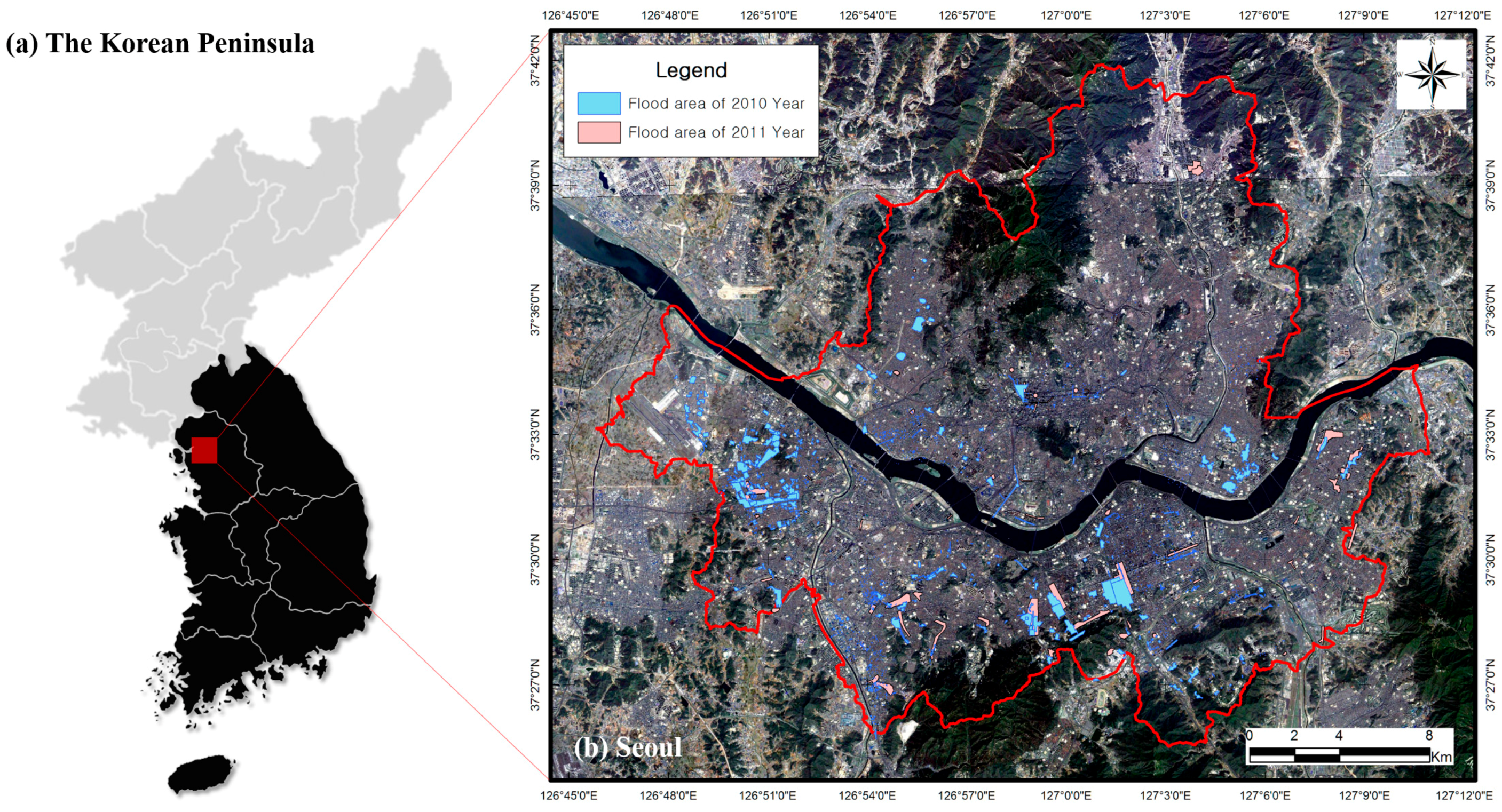
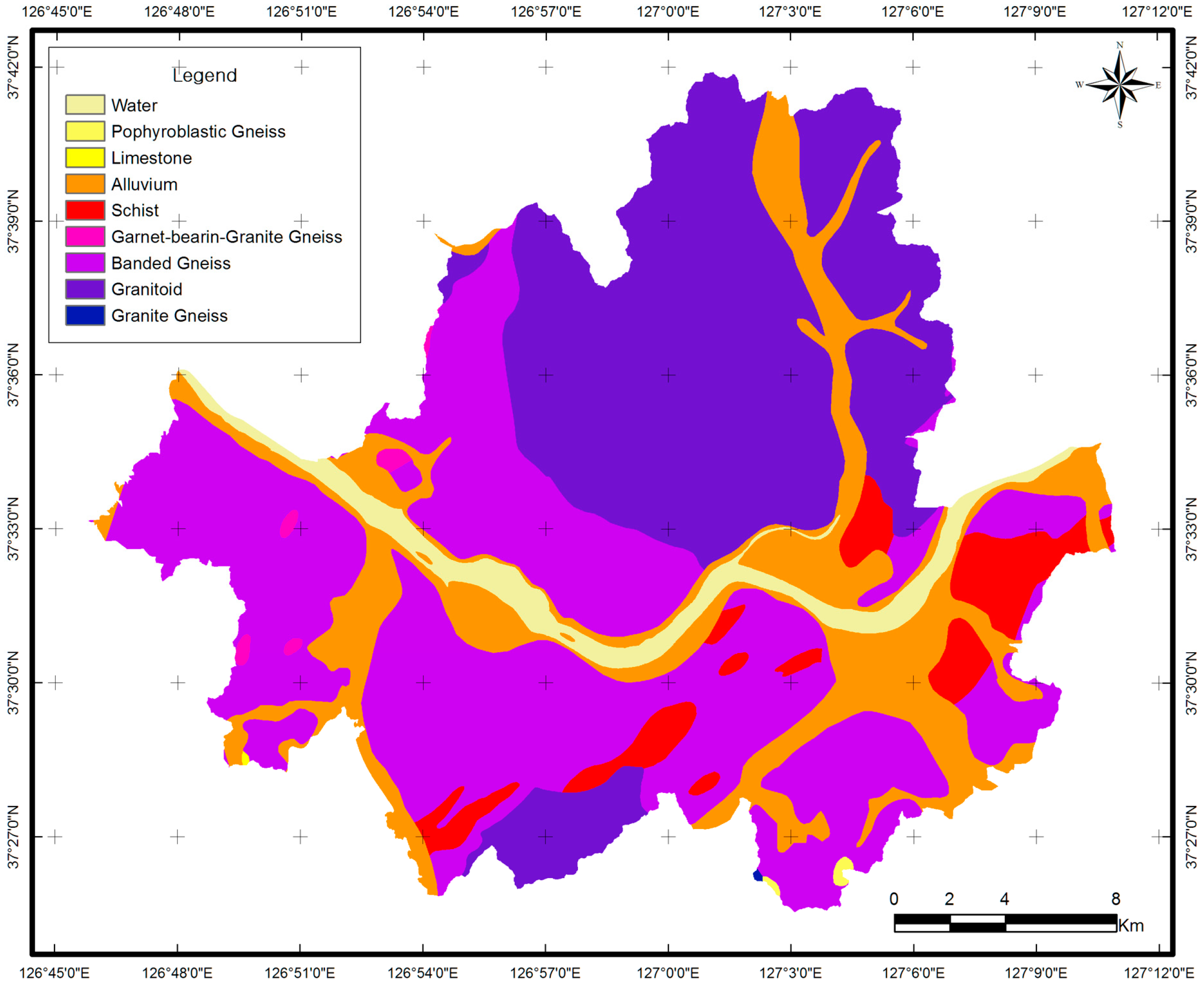
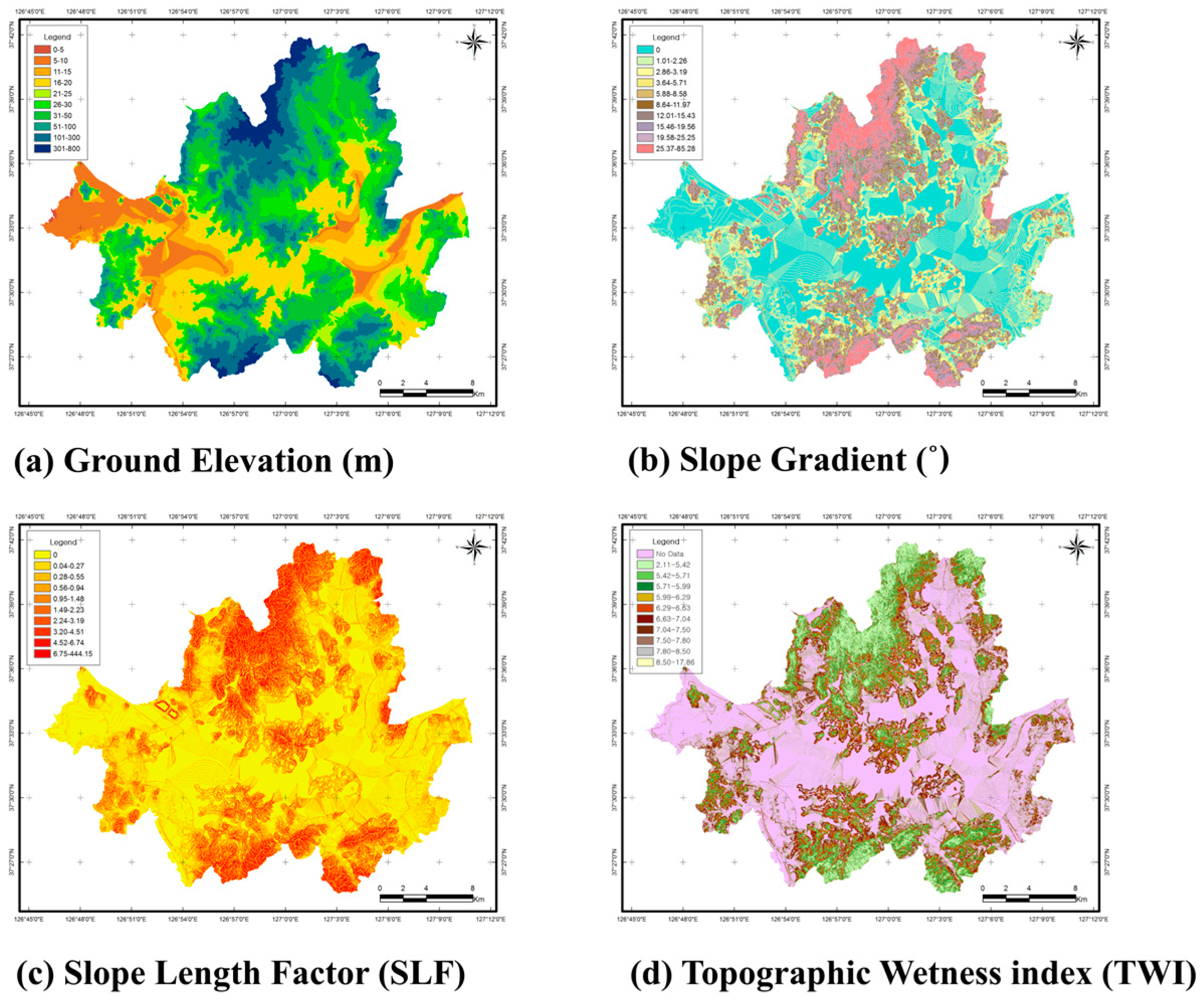

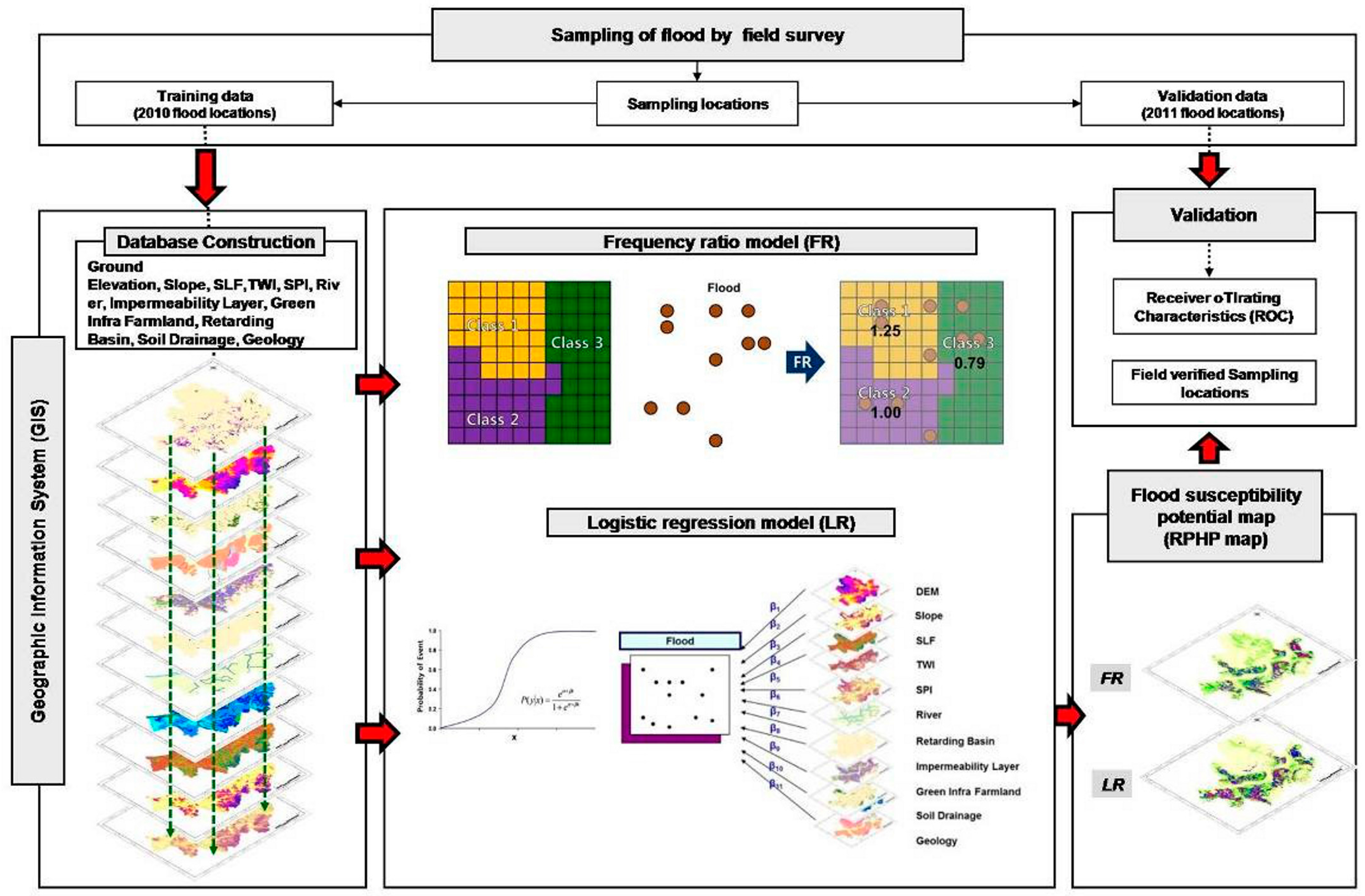
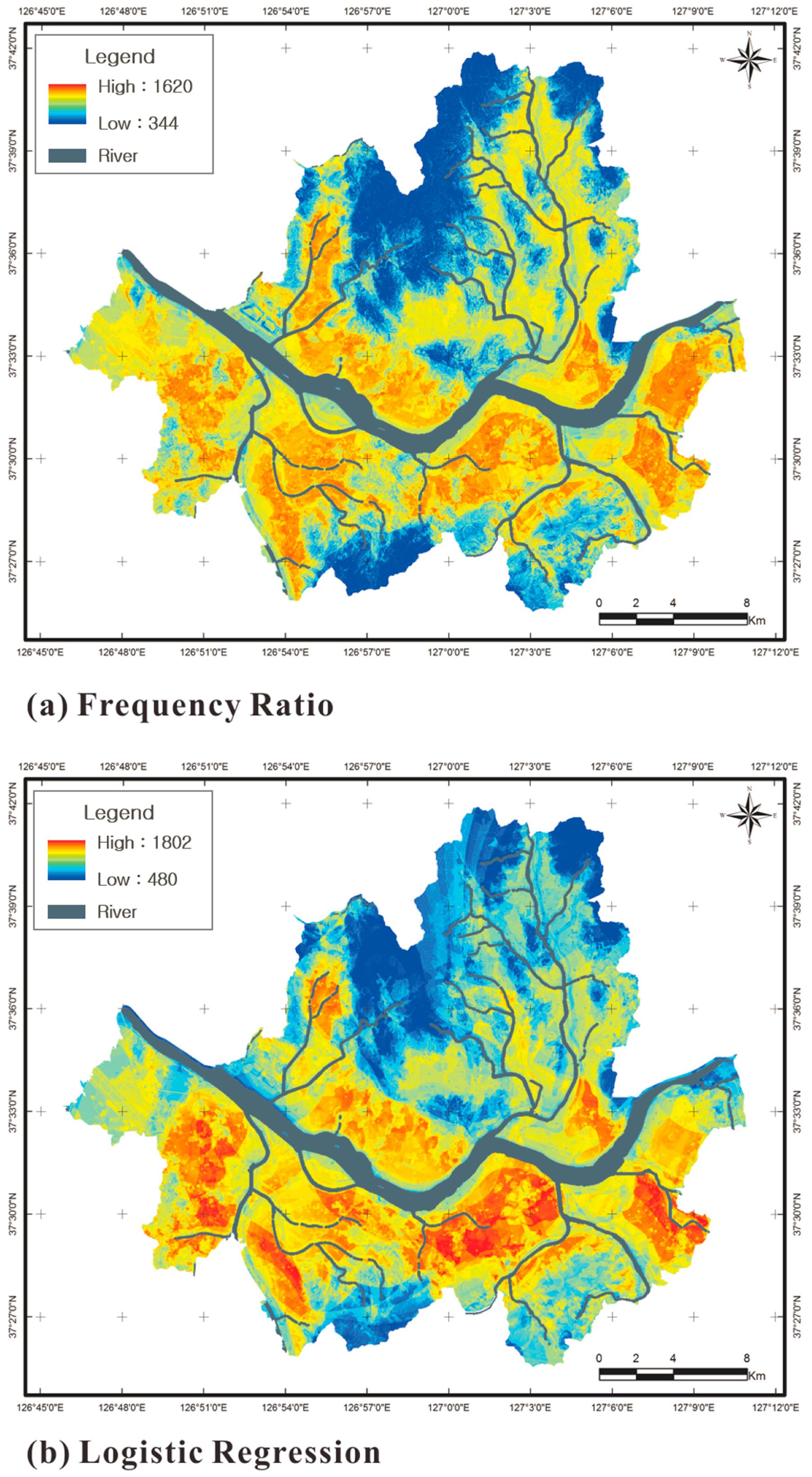
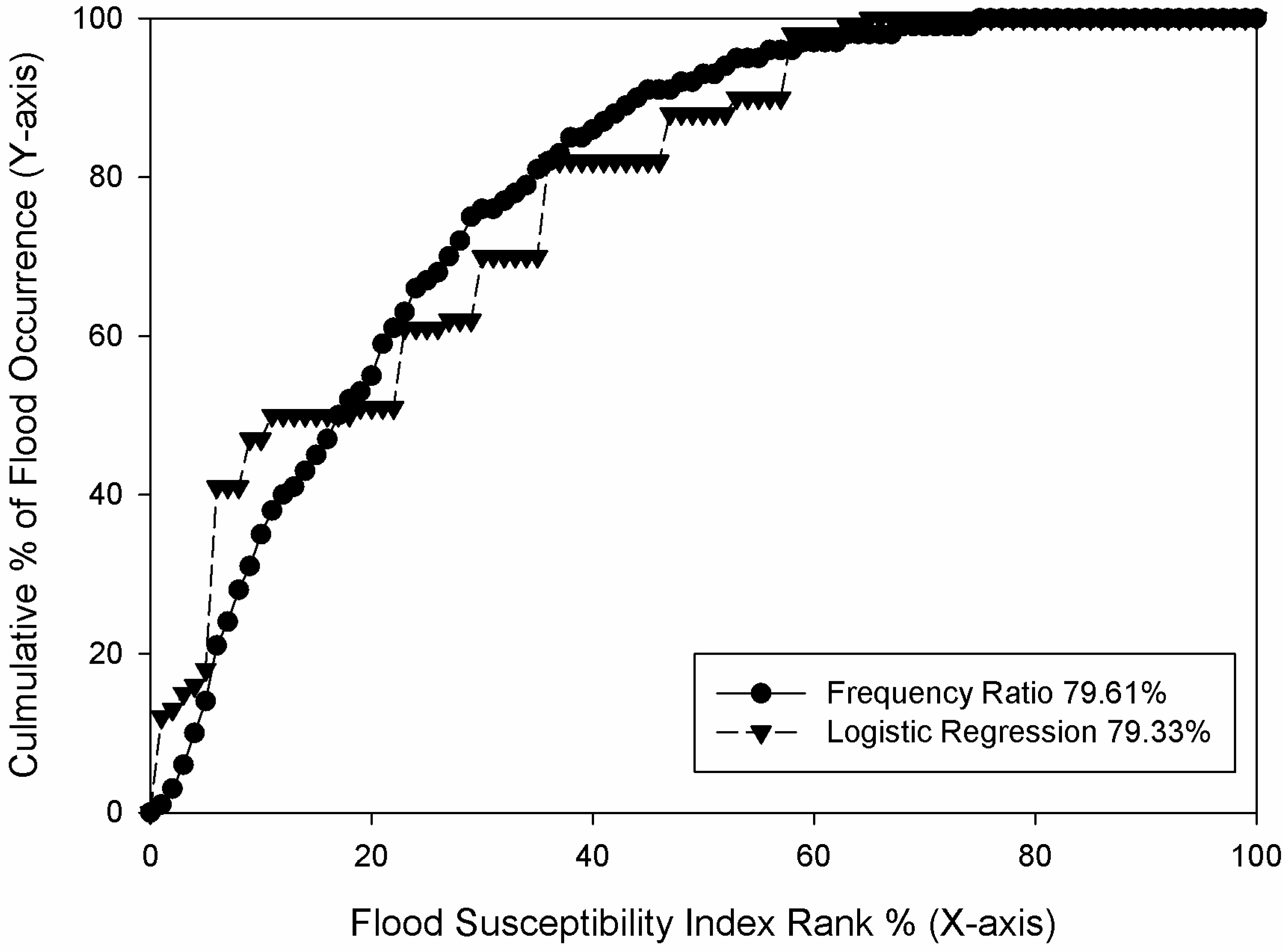
| Category | Factors | Data Type | Scale |
|---|---|---|---|
| Hazard (inundation trace map) a | Flooded area | Polygon | 1:1000 |
| Topographic map b | Ground elevation (m) | GRID | 1:1000 |
| Slope (°) | |||
| Slope length factor (SLF) | |||
| Topographic wetness index (TWI) | |||
| Stream power index (SPI) | |||
| Distance from the river | |||
| Land use and land registration map | Type of impermeable land use | Polygon | 1:25,000 |
| Type of agricultural land use | |||
| Retarding basin | |||
| Soil map c | Soil drainage | Polygon | 1:25,000 |
| Geological map d | Geology | Polygon | 1:25,000 |
| Factor | Class | No. of Flood | % of Flood | No. of Pixels in Domain b | % of Pixels in Domain | Frequency Ratio |
|---|---|---|---|---|---|---|
| Ground elevation (m) | 0−5 | 0 | 0.00 | 8430 | 0.14 | 0.00 |
| 5−10 | 8118 | 6.39 | 489,094 | 8.06 | 0.79 | |
| 11−15 | 4391 | 3.46 | 403,484 | 6.65 | 0.52 | |
| 16−20 | 33,072 | 26.02 | 1,015,155 | 16.72 | 1.56 | |
| 21−25 | 12,763 | 10.04 | 361,080 | 5.95 | 1.69 | |
| 26−30 | 22,342 | 17.58 | 706,376 | 11.64 | 1.51 | |
| 31−50 | 37,396 | 29.43 | 1,230,145 | 20.27 | 1.45 | |
| 51−100 | 7518 | 5.92 | 896,300 | 14.77 | 0.40 | |
| 101−300 | 1487 | 1.17 | 750,673 | 12.37 | 0.09 | |
| 301−800 | 0 | 0.00 | 208,967 | 3.44 | 0.00 | |
| Slope gradient (˚) | 0 | 59,623 | 46.90 | 2,521,876 | 41.55 | 1.13 |
| 1.01−2.26 | 14,151 | 11.19 | 478,891 | 7.89 | 1.42 | |
| 2.86−3.19 | 17,565 | 13.84 | 591,965 | 9.75 | 1.42 | |
| 3.64−5.71 | 10,596 | 8.32 | 380,452 | 6.27 | 1.33 | |
| 5.88−8.58 | 7725 | 6.07 | 362,489 | 5.97 | 1.02 | |
| 8.64−11.97 | 5667 | 4.45 | 350,639 | 5.78 | 0.77 | |
| 12.01−15.43 | 4571 | 3.59 | 348,487 | 5.74 | 0.63 | |
| 15.46−19.56 | 3779 | 2.97 | 347,157 | 5.72 | 0.52 | |
| 19.58−25.25 | 2557 | 2.01 | 344,189 | 5.67 | 0.35 | |
| 25.37−85.28 | 853 | 0.67 | 343,559 | 5.66 | 0.12 | |
| SLF | 0 | 77,724 | 61.03 | 3,409,873 | 56.18 | 1.09 |
| 0.04−0.27 | 9290 | 7.29 | 299,029 | 4.93 | 1.48 | |
| 0.28−0.55 | 9118 | 7.16 | 300,560 | 4.95 | 1.45 | |
| 0.56−0.94 | 8095 | 6.36 | 296,277 | 4.88 | 1.30 | |
| 0.95−1.48 | 6809 | 5.35 | 300,512 | 4.95 | 1.08 | |
| 1.49−2.23 | 5331 | 4.19 | 295,857 | 4.87 | 0.86 | |
| 2.24−3.19 | 4218 | 3.31 | 293,309 | 4.83 | 0.69 | |
| 3.20−4.51 | 3281 | 2.58 | 292,385 | 4.82 | 0.53 | |
| 4.52−6.74 | 2315 | 1.82 | 290,981 | 4.79 | 0.38 | |
| 6.75−444.15 | 1167 | 0.92 | 290,921 | 4.79 | 0.19 | |
| TWI | No Data | 67,183 | 53.10 | 2,522,124 | 41.55 | 1.28 |
| 2.11−5.42 | 857 | 0.68 | 355,330 | 5.85 | 0.12 | |
| 5.42−5.71 | 1697 | 1.34 | 354,821 | 5.85 | 0.23 | |
| 5.71−5.99 | 2317 | 1.83 | 355,598 | 5.86 | 0.31 | |
| 5.99−6.29 | 2960 | 2.34 | 354,962 | 5.85 | 0.40 | |
| 6.29−6.63 | 4303 | 3.40 | 355,132 | 5.85 | 0.58 | |
| 6.63−7.04 | 6996 | 5.53 | 368,520 | 6.07 | 0.91 | |
| 7.04−7.50 | 8977 | 7.10 | 351,981 | 5.80 | 1.22 | |
| 7.50−7.80 | 10,745 | 8.49 | 350,659 | 5.78 | 1.47 | |
| 7.80−8.50 | 10,677 | 8.44 | 350,360 | 5.77 | 1.46 | |
| 8.50−17.86 | 9811 | 7.75 | 350,225 | 5.77 | 1.34 | |
| SPI | 0 | 77,724 | 61.16 | 3,409,873 | 56.18 | 1.09 |
| 0.02−0.14 | 8963 | 7.05 | 295,658 | 4.87 | 1.45 | |
| 0.14−0.26 | 7417 | 5.84 | 315,328 | 5.20 | 1.12 | |
| 0.26−0.41 | 5707 | 4.49 | 293,156 | 4.83 | 0.93 | |
| 0.41−0.60 | 5341 | 4.20 | 292,847 | 4.82 | 0.87 | |
| 0.60−0.83 | 4959 | 3.90 | 293,017 | 4.83 | 0.81 | |
| 0.83−1.12 | 4620 | 3.64 | 293,265 | 4.83 | 0.75 | |
| 1.12−1.50 | 4343 | 3.42 | 292,669 | 4.82 | 0.71 | |
| 1.50−2.20 | 4372 | 3.44 | 292,165 | 4.81 | 0.71 | |
| 2.20−11.82 | 3902 | 3.07 | 291,726 | 4.81 | 0.64 | |
| Distance from the river | No Data | 123,744 | 97.12 | 5,289,682 | 87.15 | 1.11 |
| 10 m buffer | 552 | 0.43 | 384,501 | 6.33 | 0.07 | |
| 50 m buffer | 1288 | 1.01 | 183,258 | 3.02 | 0.33 | |
| 100 m buffer | 1835 | 1.44 | 212,271 | 3.50 | 0.41 | |
| Type of impermeable land use | No data | 24,032 | 18.86 | 2,434,555 | 0.47 | 40.11 |
| Residential area | 50,141 | 39.35 | 1,779,996 | 1.34 | 29.33 | |
| Manufacturing area | 769 | 0.60 | 50,322 | 0.73 | 0.83 | |
| Commercial area | 19,455 | 15.27 | 521,668 | 1.78 | 8.59 | |
| Recreational area | 592 | 0.46 | 56,468 | 0.50 | 0.93 | |
| Trafficked area | 21,837 | 17.14 | 734,043 | 1.42 | 12.09 | |
| Public area | 10,593 | 8.31 | 492,660 | 1.02 | 8.12 | |
| Type of agricultural land use | Non-green farm | 119,531 | 93.81 | 5,122,219 | 84.39 | 1.11 |
| Paddy | 686 | 0.54 | 99,829 | 1.64 | 0.33 | |
| Field | 1188 | 0.93 | 144,320 | 2.38 | 0.39 | |
| Orchard | 0 | 0.00 | 3745 | 0.06 | 0.00 | |
| Other plantations | 0 | 0.00 | 1649 | 0.03 | 0.00 | |
| Natural grassland | 31 | 0.02 | 5401 | 0.09 | 0.27 | |
| Grassland | 2457 | 1.93 | 476,247 | 7.85 | 0.25 | |
| Barren ground | 3526 | 2.77 | 216,302 | 3.56 | 0.78 | |
| Retarding Basin | No data | 127,335 | 99.93 | 6,054,729 | 99.75 | 1.00 |
| Retarding basin | 84 | 0.07 | 14,983 | 0.25 | 0.27 | |
| Soil drainage | No data | 705 | 0.55 | 634,006 | 10.45 | 0.05 |
| Poorly drained | 3216 | 2.53 | 118,688 | 1.96 | 1.29 | |
| Somewhat poorly drained | 32,832 | 25.83 | 1,270,310 | 20.93 | 1.23 | |
| Moderately well drained | 73,913 | 58.16 | 2,122,951 | 34.98 | 1.66 | |
| Very well drained | 16,421 | 12.92 | 1,923,788 | 31.69 | 0.41 | |
| Geology | Water | 214 | 0.17 | 258,197 | 4.25 | 0.04 |
| Pophyroblastic gneiss | 0 | 0.00 | 6595 | 0.11 | 0.00 | |
| Limestone | 0 | 0.00 | 1061 | 0.02 | 0.00 | |
| Alluvium | 15,093 | 11.85 | 1,083,285 | 17.85 | 0.66 | |
| Schist | 12,946 | 10.16 | 303,291 | 5.00 | 2.03 | |
| Garnet-bearing-granite gneiss | 779 | 0.61 | 20,736 | 0.34 | 1.79 | |
| Banded gneiss | 92,726 | 72.77 | 2,428,763 | 40.01 | 1.82 | |
| Granitoid | 5661 | 4.44 | 1,966,740 | 32.40 | 0.14 | |
| Granite gneiss | 0 | 0.00 | 1044 | 0.02 | 0.00 |
| Factor | B | S.E | Wals | Sig. | |
|---|---|---|---|---|---|
| Ground elevation (m) | −0.007 | 0.000 | 273.401 | 0.000 | |
| Slope gradient (°) | −0.005 | 0.002 | 4.284 | 0.038 | |
| SLF | −0.006 | 0.008 | 0.663 | 0.416 | |
| TWI | 0.020 | 0.003 | 57.420 | 0.000 | |
| SPI | −0.025 | 0.017 | 2.054 | 0.152 | |
| Distance from the river | 0.001 | 0.000 | 3978.433 | 0.000 | |
| Type of impermeable land use | No data | −0.229 | 0.033 | 717.704 | 0.000 |
| Residential area | 0.156 | 0.028 | |||
| Manufacturing area | −0.440 | 0.086 | |||
| Commercial area | 0.489 | 0.032 | |||
| Recreational area | −0.116 | 0.095 | |||
| Trafficked area | 0.180 | 0.031 | |||
| Public area | 0.000 | 0.000 | |||
| Type of agricultural land use | Non-green farm | −0.079 | 0.050 | 517.979 | 0.000 |
| Paddy | −1.814 | 0.106 | |||
| Field | −1.171 | 0.084 | |||
| Orchard | −16.906 | 1901.109 | |||
| Other plantations | −17.699 | 2883.907 | |||
| Natural grassland | −0.525 | 0.385 | |||
| Grassland | −0.252 | 0.068 | |||
| Barren ground | 0.000 | 0.000 | |||
| Retarding basin | No data | 1.485 | 0.335 | 19.647 | 0.000 |
| Retarding basin | 0.000 | 0.000 | |||
| Soil drainage | No data | −1.215 | 0.092 | 1048.151 | 0.000 |
| Poorly drained | 0.383 | 0.065 | |||
| Somewhat poorly drained | 0.400 | 0.025 | |||
| Moderately well drained | 0.579 | 0.022 | |||
| Very well drained | 0.000 | 0.000 | |||
| Geology | Water | 14.116 | 3789.108 | 3854.436 | 0.000 |
| Pophyroblastic gneiss | 0.056 | 4055.009 | |||
| Limestone | −1.683 | 5242.473 | |||
| Alluvium | 16.177 | 3789.108 | |||
| Schist | 16.657 | 3789.108 | |||
| Garnet-bearing-granite gneiss | 16.653 | 3789.108 | |||
| Banded gneiss | 16.755 | 3789.108 | |||
| Granitoid | 14.893 | 3789.108 | |||
| Granite gneiss | 0.000 | 0.000 | |||
© 2018 by the authors. Licensee MDPI, Basel, Switzerland. This article is an open access article distributed under the terms and conditions of the Creative Commons Attribution (CC BY) license (http://creativecommons.org/licenses/by/4.0/).
Share and Cite
Lee, S.; Lee, S.; Lee, M.-J.; Jung, H.-S. Spatial Assessment of Urban Flood Susceptibility Using Data Mining and Geographic Information System (GIS) Tools. Sustainability 2018, 10, 648. https://doi.org/10.3390/su10030648
Lee S, Lee S, Lee M-J, Jung H-S. Spatial Assessment of Urban Flood Susceptibility Using Data Mining and Geographic Information System (GIS) Tools. Sustainability. 2018; 10(3):648. https://doi.org/10.3390/su10030648
Chicago/Turabian StyleLee, Sunmin, Saro Lee, Moung-Jin Lee, and Hyung-Sup Jung. 2018. "Spatial Assessment of Urban Flood Susceptibility Using Data Mining and Geographic Information System (GIS) Tools" Sustainability 10, no. 3: 648. https://doi.org/10.3390/su10030648







